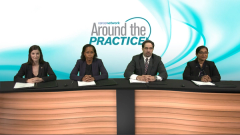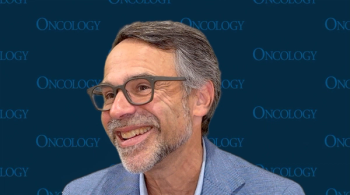
Maintenance Therapy Considerations for Standard- and High-Risk MM
Experts on multiple myeloma offer clinical insights on treatment options and considerations for patients with standard- and high-risk multiple myeloma.
Episodes in this series

Transcript:
Al-Ola Abdallah, MD: Leyla, back to you, this is a case of high-risk myeloma and I think this is an open debate. We don’t have an answer for that, but you can tell us exactly your opinion about standard risk. For example, what maintenance therapy [is] recommended in patients with standard risk.
Leyla O. Shune, MD: So, standard risk is the easy one because we have a study to support maintenance [with a] single agent, which has shown improved OS [overall survival]. So, across the board, standard-risk myeloma patients, unless they enrolled on a trial, we give them proper maintenance.
Al-Ola Abdallah, MD: We opened together the DRAMMATIC trial here. Give us your input about the study itself, and importance for that in the future.
Leyla O. Shune, MD: The DRAMMATIC trial is being conducted by SWOG it’s open at multiple centers, and it’s accruing ahead of schedule. We are excited to hear the results. The DRAMMATIC trial is a phase 3, randomized trial that looked at patients who have received transplant. They’re randomized to either daratumumab plus our standard of care, Revlimid, or our standard of care, Revlimid, alone.
Both groups will receive maintenance therapy until 2 years, at which point we take an MRD [minimal residual disease] study. If [the patient is] MRD negative, here’s an opportunity for us to randomize the patients to either continue on their assigned maintenance therapy or come off maintenance therapy. So, this is the first study we have looking at an opportunity to use MRD-directed discontinuation of maintenance therapy. We’re excited to hear the results because it will really answer many questions from our patients about “When can I stop Revlimid.”
Al-Ola Abdallah, MD: I think that’s also really a [big] thing. That’s the reason why, as a clinician, that plays a big role. Patients always ask the question, “With my complete remission, why am I continuing the treatment? What’s the whole benefit to this?” This is the kind of a study I was talking about [where] randomizing will tell me the benefit of stopping it vs continuing.
Nausheen Ahmed, MD: [Dr]Abdallah, so now the difficult question, what’s your standard of care for high-risk myeloma?
Al-Ola Abdallah, MD: I’ll be honest with you, there’s no way to say the words “standard of care”since we don’t have a good randomized trial. What we did here as colleagues, we came back and we look at all the studies. The SWOG study was maybe the closest that we have [as a] randomized trial without transplant. We opted that we need transplant in all high-risk myeloma if they’re fit and eligible. The induction therapy, I think it’s always question about RVd [lenalidomide, bortezomib, dexamethasone]vs daratumumab-RVd. I think the strategy we have here, and some of us will agree or disagree, if the daratumumab was going to add a cure, it’s worth it to add it. If it’s not going to add a cure, and I know the patient’s going to relapse, why not save it for when it’s really needed, like in first relapse? So, I think there’s a lot of question marks.
I think the maintenance therapy is where a lot of debate happens here. And what we did is that we looked at the SWOG study, and we looked at some retrospective studies, and we opted that Velcade [bortezomib]-Revlimid will be the best option, considering Revlimid is the backbone and adding the Velcade can keep these patients in remission. However, it doesn’t mean that’s the standard of care, that’s just the closest that we have here. And I think that’s where we would like to kind of continue doing what we’re doing so far.
Nausheen Ahmed, MD: And then what are your thoughts about the retrospective study from CIBMTR [Center for International Blood and Marrow Transplant Research]?
Al-Ola Abdallah, MD: I saw that retrospective study and it was kind of impressive. They have over 508 patients they collected who are really high-risk myeloma patients. [It showed] that Revlimid [alone] was superior to Velcade, or Velcade with Revlimid. I don’t know exactly how accurate it is to say that. It’s a retrospective study. I would not change my standard of care based on the retrospective study, but I will actually consider this as an opportunity. If you have an ability to collect data for 500 patients, through all the institutions, you can actually do a prospective study for 200 to 300 patients. At least we can actually develop a new standard of care for myeloma patients in that regard.
Actually, [to give] the question to Jordan, since we’re using maintenance therapy [of] Velcade and Revlimid in high-risk myeloma, can you tell us a little bit about the long-term side effects for these patients? Patients don’t like to come, but they’re high-risk and they opted to have been on the Velcade and Revlimid.
Jordan Snyder, PharmD: So, I think one of the biggest issues we have with maintenance, especially in the high-risk patients, is these patients are going to be on maintenance for years. That’s very burdensome coming to the clinic frequently, it’s a financial burden. So, that in of itself, I think, is a huge issue that we run into quite frequently in our practice. And then [there are] long-term side effects. With the Revlimid we see increasing cytopenias the longer they’re on it. We see those secondary malignancies, especially after they’ve been on it for years at a time. Then with the Velcade [there is] neuropathy. It can be pretty significant and I feel like our patients definitely have a decrease in quality of life once they start dealing with neuropathy. It can be really difficult to treat and it takes a long time for that to go away. I feel like those are some of the biggest issues we’re running into with our maintenance therapy.
Al-Ola Abdallah, MD: Thank you very much, Jordan.
Transcript edited for clarity.
Newsletter
Stay up to date on recent advances in the multidisciplinary approach to cancer.























































































